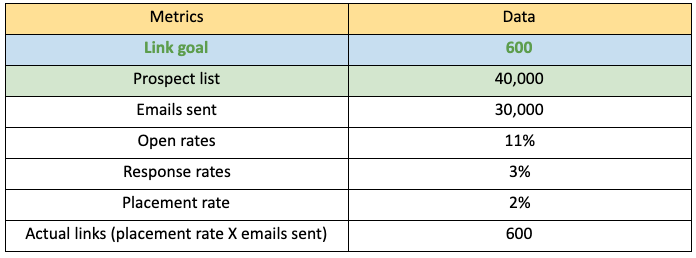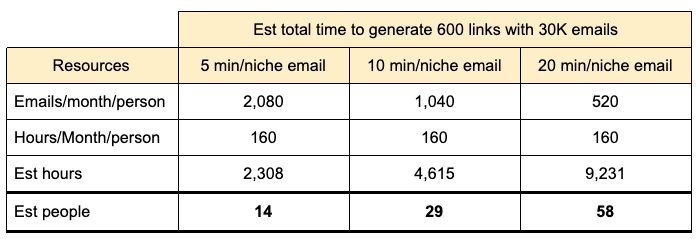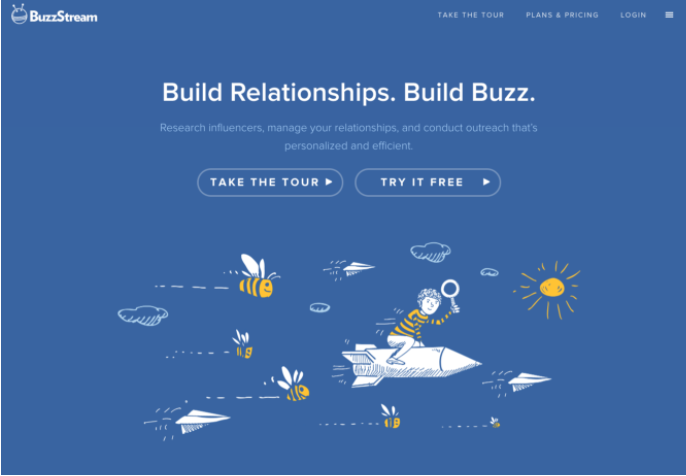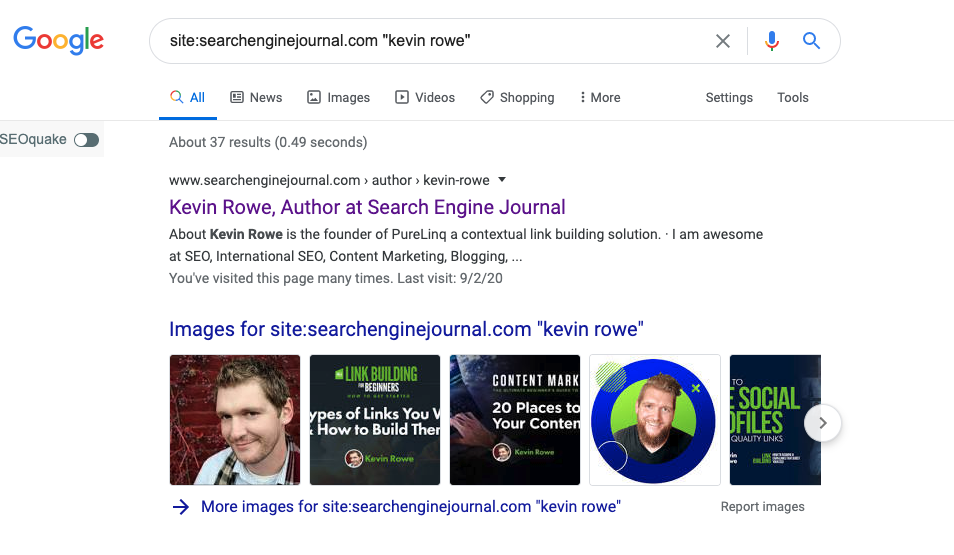I don’t want to trivialize the amount of work and planning that went into this major win.
More than 600 links in one month with two people, with one-to-one outreach, is an anomaly for many SEO professionals or content marketers.
But the work started way before the actual project began, and I’ll explain further about how to align the right resources to realize similar results.
Open rates on email campaigns can be lower, but you can expect them to be 10-25%.
This assumes you have an opt-in email list.
Link building has traditionally implemented cold email tactics, which hold a sub-5% open rate and even lower successful placement rates.
A micro-targeted outreach campaign can increase response rates for sure, but niche email outreach still isn’t enough to drive 600 links with two people in one month.
In the table below – I’ve made a few assumptions on placement and response rates based on my own experience – you can see that it takes 30,000 sent emails to reach 600 live link placements.

There are several key projects that go into obtaining these 600 links:
- Prospect list building.
- Identifying emails and contact people.
- Custom building targeted emails addressing each audience.
- Content creation in many cases.
- Email/phone call outreach. (Yes, phone calls.)
- Follow-ups.
- Verify placements.
The two most time-consuming facets of this process are prospect list building and custom niche email setup.
Your placement rates will be low without custom emails that tie your pitch into the publisher’s audience.
I use a general rule that it takes five to 20 minutes per prospect to get an email out.
As you can see in the table below, this can take 14-58 people a month of emails and calls to secure.

This level of effort simply isn’t realistic for most companies.
The solution to generating 600 links with fewer people is relatively simple:
Generate a 90% successful placement rate.
Easy, right?
In order to get this rate, you’ll need to focus on three key areas:
- Relationships.
- Technology.
- Systems or processes.
And you may think this is counterintuitive, but you will also want to eliminate all content production.
Despite the great amount of information about the need for content to link building, this process requires no content.
You will be focusing on two strategies:
- Thematic reclamation: Find articles with a keyword, product, or application and get a link inserted into that article.
- Unlinked brand mentions: Find mentions of your product, brand name, or event executives’ names and request a link back.
Relationships with Authors, Editors, Publishers
I spent three years building our relationships with over 50,000 bloggers, influencers, authors, and editors.
And with this, we now have a greater than 90% successful placement rate on average.
Relationships are a key resource to scale.
With a 90% response rate, you’ll only need access to less than 700 sites to drive 600+ placements.
You’ve cut your link building level of effort to a point where one SEO can manage it.
This level of sales requires a lot of work.
But spread out over three years, I built the list with one or two outreach specialists at any given time.
However, you may not want to reuse the same publication several times, and instead, secure a high number of unique referring domains or unique IP links.
This is possible, but focus on finding authors that contribute to multiple blogs and new sites.
This will dramatically increase your publication options.
When I first started, we used two tools: Muck Rack and BuzzStream.
Muck Rack offers access to authors or writers who contribute to major publications, but BuzzStream is the lower-cost option.

Technology to Manage Inventory & Outreach
The technology breaks into two categories:
- Storage and filtering publishers or authors.
- Email outreach.
With a small list of under 100 sites, you can use Google Sheets to easily manage the storage and handle the outreach through Gmail or your own email systems.
As your list grows, you’ll need to use a database.
I have found personally that most of the tools like Pitch Box, BuzzStream, or Ninja Outreach work well for small lists or custom outreach but not for large scale list building with thousands or tens of thousands of sites.
That’s why I build my own system to manage, but BuzzStream will work well for a small goal of a few thousand sites.

Selecting a tool that allows you to store your contacts and manage the email workflow is ideal.
To find unlinked brand mentions or thematic articles, you’ll need a way to search the sites for articles.
You can do this by searching the site in Google by using the “site:” search operators like I did in the screenshot below.

However, that’s fairly manual.
I have used Ahrefs’ Content Explorer before building my own search engine.
It allows you to find pages that exclude links to your site, a major time saver.

Or, if you want to go to the next level, you can build your own search engine using an open-source system like Sphinx or Elastic search.
After I built a search engine and indexed the sites in our database, the process of mining through sites became much faster.

Process to Scale
Establishing a process is actually simple for unlinked brand mentions or thematic reclamation.
I use the 3-step process documenter approach from EOS to build what I call the Linq Mining process.
If you’re not going to spend the time/resources to build your own search engine, then here is a simple process to follow:
- Store sites in BuzzStream.
- Search through your stored sites in BuzzStream based on niche, and any metrics you deem important (e.g., domain authority).
- Use Ahrefs to find specific pages for thematic mentions or unlinked brand mentions.
- After you have the pages set up, reach out to your personal contact in BuzzStream. But don’t automate. These should be 1-to-1 outreach.
- Verify when links are live directly on the site. It will take a little time for Ahrefs and Google to index, so I prefer to either crawl the site or manually visit it.
Relationships Are Key
Generating 600 links from 600 unique referring domains is not an easy task.
You will need to put the effort in to build out relationships between you and authors.
This should be a standard monthly project ongoing to find, build, and maintain these relationships.
I’ve actually found that offering a simple, free broken link audit you can run with Screaming Frog can go a long way in building a relationship with a publisher, opening up the conversation to talk about guest posting or link inserts.
More Resources:
- Link Building for SEO: A Complete Guide
- 4 Link Building Research Tips to 10x Your Links
- 50 Types of Links You Want & How to Build Them
Image Credits
Fearured & In-Post Images: Created by author, September 2020
All screenshots taken by author, September 2020





